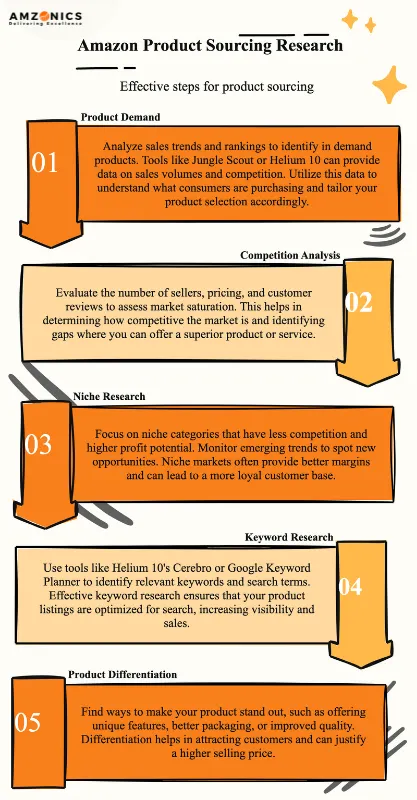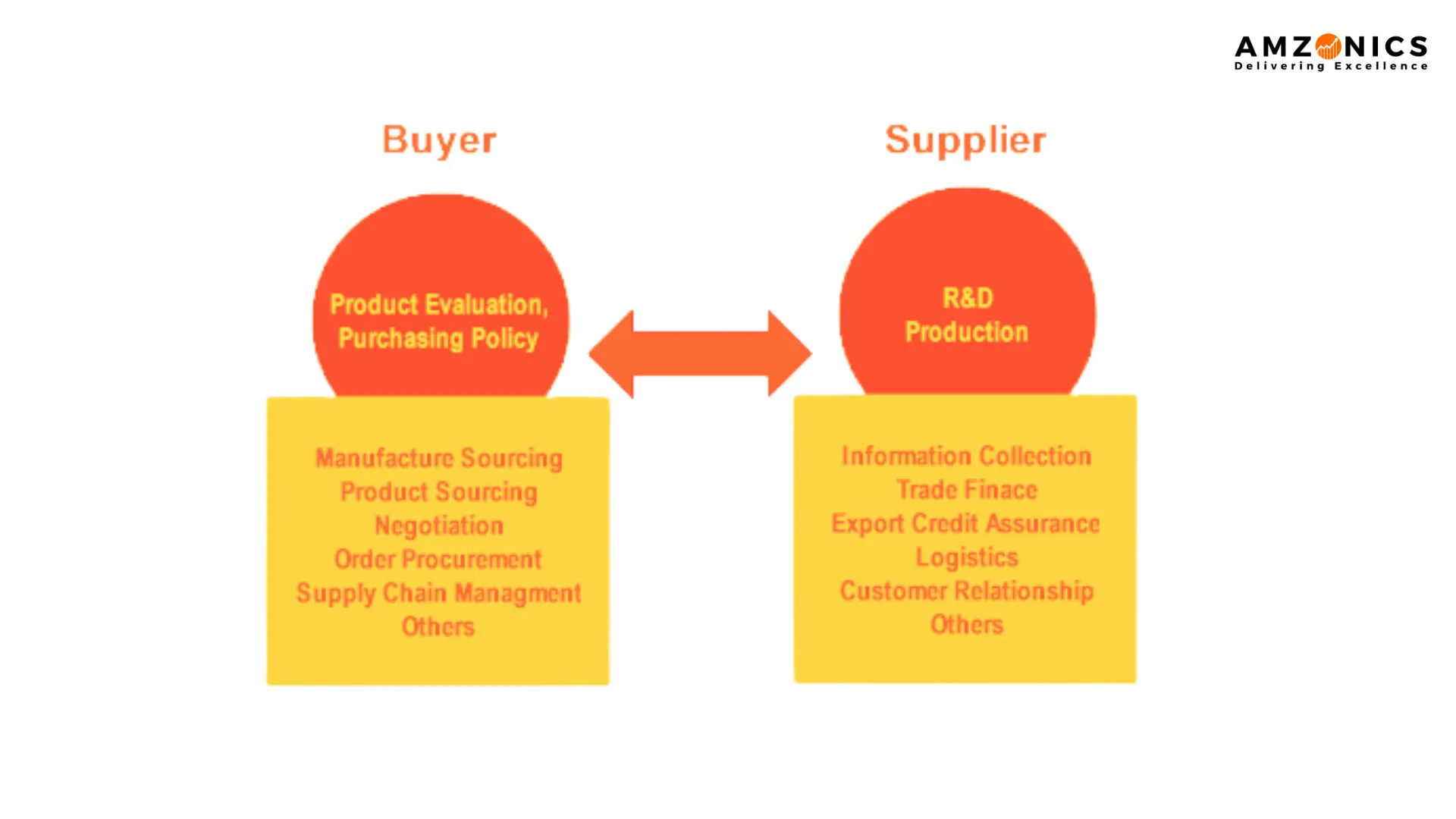What Is Amazon Product Sourcing? Your Ultimate Guide

Amazon product sourcing is the process of finding and acquiring products to sell on the Amazon platform. This involves identifying suppliers, evaluating their products, negotiating terms, and ultimately selecting inventory that aligns with your business goals and target audience.
Why is Amazon Product Sourcing Important?
Product sourcing directly impacts quality, pricing, availability, and customer satisfaction, all of which are critical for success on Amazon. Effective sourcing ensures cost efficiency, competitive pricing, and the ability to meet customer demand. It also helps you avoid common pitfalls such as counterfeit goods and stockouts.
Key benefits of effective product sourcing include:
-
Quality and Reliability: Ensures you provide high quality products.
-
Competitive Advantage: Allows you to find unique products or differentiate from competitors.
-
Profitability: Maximizes margins through competitive pricing from suppliers.
-
Inventory Management: Helps maintain optimal stock levels.
-
Market Demand: Aligns products with current customer interests.
-
Scalability: Enables future business growth with consistent sourcing.
-
Customer Satisfaction: Increases trust and brand loyalty.
-
Risk Mitigation: Reduces the chances of selling counterfeit or poorquality products.
Determining Product Eligibility
Before diving into product sourcing, it is essential to confirm whether your chosen product is eligible for sale on Amazon. Amazon has strict guidelines, especially for restricted categories like hazardous materials or branded items, which may require additional documentation or approval. Following Amazon's guidelines on product quality and safety is crucial to avoid future issues such as listing removal or account suspension.
Different Types of Amazon Product Sourcing
There are several methods for sourcing products to sell on Amazon:
-
Wholesale Sourcing: Purchasing products in bulk from established brands.
-
Private Label: Manufacturing your own branded product through thirdparty suppliers.
-
Dropshipping: Selling products without holding inventory; suppliers ship directly to customers.
-
Retail Arbitrage: Buying products at a lower price from retailers and reselling on Amazon.
-
Online Arbitrage: Similar to retail arbitrage but sourcing from online stores.
-
Handmade: Selling handmade goods directly through Amazon's Handmade platform.
Each method has its own pros and cons, depending on your budget, resources, and expertise.
Market Research for Amazon Product Sourcing

Product research is the foundation of successful sourcing. Here’s how you can conduct effective market research
Product Demand: Analyze sales trends and rankings to identify in demand products. Tools like Jungle Scout or Helium 10 can provide data on sales volumes and competition.
Competition Analysis: Evaluate the number of sellers, pricing, and customer reviews to assess market saturation.
Niche Research: Focus on niche categories that have less competition and higher profit potential. Monitor emerging trends to spot new opportunities.
Keyword Research: Use tools like Helium 10's Cerebro or Google Keyword Planner to identify relevant keywords and search terms.
Product Differentiation: Find ways to make your product stand out, such as offering unique features, better packaging, or improved quality.
Pricing Analysis: Analyze competitors’ pricing strategies and identify opportunities to offer competitive pricing.
Trend Analysis: Monitor industry blogs and Amazon's Best Sellers list to keep up with trends and emerging markets. Identifying Profitable Niches
Product niches on Amazon refer to specific categories or subcategories that target particular customer groups. Some profitable niches include:
Fitness and wellness products
Home and kitchen items
Electronics and gadgets
Beauty and personal care
Pet supplies
Fashion and accessories
Niche Research and Selection Techniques
- Keyword Research: Find profitable niches by identifying keywords with high search volume but low competition.
- Trend Analysis: Keep an eye on trending categories or new product ideas from sources like social media or trade shows.
- Product Differentiators: Offer unique features or address unmet customer needs to differentiate your product.
- Customer Feedback: Analyze reviews to understand pain points and identify opportunities for improvement.
Supplier Research and Selection
Finding reliable suppliers is key to sourcing quality products consistently. Here are some ways to identify and vet potential suppliers:
- Online Supplier Directories: Use platforms like Alibaba or Global Sources to find suppliers. These directories provide reviews, product details, and contact information.
- Supplier Verification: Always verify the legitimacy of suppliers through research, references, and background checks.
- Trade Shows and Exhibitions: Attending industry events allows you to connect with suppliers in person and evaluate their products firsthand.
- Supplier Audits: Conducting audits or working with third party inspection services can help verify supplier quality control processes.
- Communication and Responsiveness: Good communication is crucial. Evaluate how responsive and transparent a supplier is before establishing long-term relationships.
- Sample Testing: Always request product samples to evaluate quality before committing to a supplier.
- Scalability: Ensure the supplier can handle increased orders as your business grows.
By mastering Amazon product sourcing, you set a strong foundation for success on the platform, optimizing your inventory, maintaining a competitive edge, and ultimately maximizing profitability.
Negotiating Favorable Terms and Pricing
Effective negotiation with suppliers is essential for Amazon sellers aiming to maximize profitability. Here are key strategies for achieving favorable terms and pricing:
-
Research and Preparation: Before negotiating, research current market prices, industry trends, and competitor pricing. Understanding the supplier’s cost structure and their willingness to negotiate will empower your position during discussions.
-
Build Relationships: Establishing strong, long-term relationships with suppliers builds trust. Suppliers may offer better deals when they know they are working with reliable partners.
-
Volume and Long-Term Commitments: Offering to buy in bulk or committing to a long-term partnership can incentivize suppliers to provide better prices or terms.
-
Product Bundling: If sourcing multiple products, negotiate for a discount by purchasing in bulk or bundling various products together.
-
Alternative Suppliers: Having multiple supplier options creates competition. Inform your supplier that you are considering other sources, which can motivate them to offer more favorable pricing.
-
Flexible Payment Terms: Negotiate payment plans that suit your cash flow needs. You can request longer payment terms or discounts for early payments.
-
Sample Testing: Always request samples before finalizing a deal to assess product quality. If the quality is satisfactory, use this information to negotiate the final price.
-
Be Ready to Walk Away: Sometimes the best leverage comes from being willing to walk away if the terms don’t meet your expectations.
Tips for Communicating with Suppliers

Effective communication is key when working with suppliers. Here’s how you can improve your interactions:
-
Clear and Concise Communication: Ensure your expectations, requirements, and product specifications are communicated clearly to avoid misunderstandings.
-
Active Listening: Pay attention to the supplier's concerns and feedback. This fosters collaboration and a better working relationship.
-
Timely Responses: Respond to supplier inquiries and requests promptly. It signals reliability and commitment.
-
Maintain Professionalism: Stay polite and professional, especially when discussing sensitive topics like pricing and delivery issues.
-
Use Multiple Communication Channels: Maintain clear lines of communication through email, phone calls, or video meetings, depending on the situation.
-
Provide Feedback: Regularly offer constructive feedback to help suppliers improve and maintain quality.
-
Document Important Conversations: Keep records of key agreements, decisions, and discussions to avoid disputes in the future.
-
FacetoFace Meetings: If possible, meet your suppliers in person to strengthen the relationship.
-
Resolve Conflicts Professionally: Address conflicts promptly and professionally to ensure smooth business operations.
Supplier Sourcing Tactics
Domestic vs. International Sourcing
Domestic Sourcing: Offers faster shipping times, which can range from a few days to two weeks. It can reduce logistics challenges but often comes with higher production costs.
International Sourcing: More costeffective, especially when sourcing from countries with lower labor costs (e.g., China, India). However, it typically involves longer shipping times, ranging from weeks to months.
Working with a Manufacturer vs. a Middleman
Manufacturer: Provides more customization options but often requires a higher initial investment and a longer time to build trust.
Middleman: Easier to work with, requiring lower upfront costs, but they can be more expensive in the long run due to markups.
When evaluating suppliers, websites like Alibaba are useful for verifying seller details, transactions, and reviews. Always start with small test orders to evaluate product quality and reliability before scaling up.
Overseas Product Sourcing

Overseas sourcing offers several advantages, including:
-
Cost Savings: Lower production and labor costs allow you to source products at more competitive prices.
-
Wider Product Range: International markets, especially in countries like China, offer unique and innovative products that may not be available domestically.
-
Scalability: Overseas suppliers often have larger production capabilities, making it easier to meet growing demand.
-
Specialized Expertise: Certain countries excel in specific product categories, allowing you to access higher-quality items by leveraging the expertise of these regions.
-
Diversification: Sourcing from multiple regions helps mitigate risks from disruptions in the supply chain due to political or natural events.
However, challenges like quality control, language barriers, and longer shipping times are common when sourcing internationally. Effective supplier relationship management and thorough due diligence are essential in overcoming these obstacles.
Whether you choose domestic or international sourcing, proper research, supplier relationship building, and negotiation are critical for success. Make sure to evaluate all options, maintain clear communication, and keep detailed records for smooth and profitable operations.
💡 For more insights and tips on optimizing your sourcing strategies, follow our blog and stay updated with the latest trends and best practices in supply chain management!
